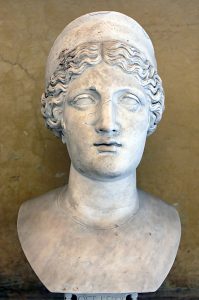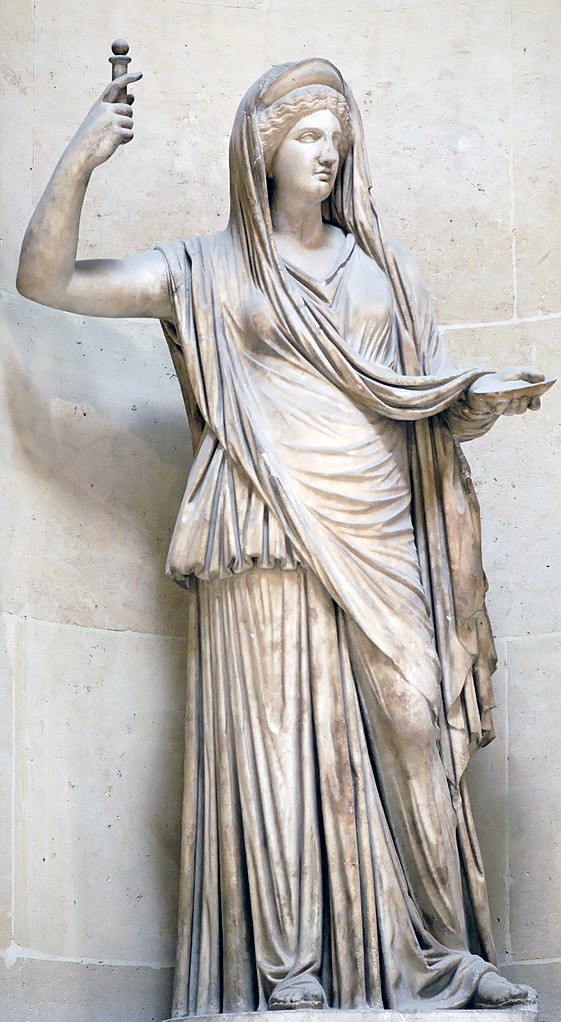Hera (Juno)
Who is Hera?
Hera (Roman name: Juno), is the Queen of the Greek gods and is the wife and sister of Zeus in the Olympian pantheon, represented the ideal woman and was goddess of marriage and the family.
Family
Hera, who was the daughter of Cronus and Rhea, was swallowed by her father. Zeus saved her from

stomach of Cronus and married her. Zeus appeared to Hera in the form of a bird chilled by the cold winter day to her bosom. However, Zeus restored to his original self and attemped to ravish her. Hera resisted but she accepted on condition that they married.According to the legend, the wedding celebration of Zeus and Hera took place at the Garden of Hesperides in the west.From this marriage between Zeus and Hera came forth Ares (god of war), Hephaestus (god of metallurgy), Eileithyia (goddess of childbirth) and Hebe (goddess of youth). Hera threw Hephaistos from Mount Olympus because of his ugliness, and crashing to earth, the god became lame. In other accounts, Hephaistos was thrown from the heavens by Zeus precisely because of his lameness. In any case, Hephaistos held a grudge against his mother and even imprisoned her in a special throne. Hera was only released from the device by promising her son the hand of Aphrodite in marriage.
Facts about Hera
A typical Greek goddess, Hera ill-tempered, quarrelsome, covetous and resentful. Therefore she appears as an obnoxious goddess. She always wanted to setle matters by crafty means; therefore, Zeus adresses her as the trickster in the Iliad.
Goddess Hera was unable to do anything aginst her rascal husband Zeus, sos he would harm the women he United in love with and the children born from these unions. There was nobody fit to hold a candle to Hera in terms of craftiness. After her life, Hera endeavored to punish Heracles, who was born from a love affair of Zeus. Zeus would sometimes lose his patience with Hera fort he things she did to Heracles and punish her by hanging her upside down, trying anvils on to her feet and golden chains on to her hands.
However, Hera would not come around. She even wanted the destruction and vanishment of Troy because a Trojan refused to give teh golden apple to her. She supported the Achaenas throughout the war. In fact, when the Trojans were driving back the Achaenas in one instance, Hera came down from Olympus hastliy, approached Zeus who was watching teh war on Mount Ida and seduced him. When Zeus fell asleep, she helped the Achaeans together with other deities. Zeus became outraged when he woke and saw what happened.
‘I see, Hera” said he,
“you mischief-making trickster,
That your cunning has stayed Hector from fighting,
And has caused the rout of his lost.
I am in a half a mind to thrash you,
In which case you will be the first reap the fruits of your scurvy knavery.
Do you not remember how once upon a time I had you hanged?”
Hera was the goddess of family ties and births. Even though she was upset by the affairs of Zeus, she never cheat on him. She possessed a reversed and mature beauty. She would g oto the spring of Kanathos every year, where she took bath and regained her virginity and beauty from enchanted waters.
Zeus and Hera
She was the most beautiful woman of Olympus after Aphrodite. Hence, many confessed their love to her yet she never felt any interest in them. Ixion, for exaple, was the major one among those who courted her. Everybody on earth hated Ixion because he had his father-in-law burnt alive; however, Zeus had forgiven him an deven accepted him to Olympus. There, Ixion plagued Hera, who in turn complained about him to Zeus. He was punished by being dumped into hell. Hera was the inherent protector of Achilles. Because she raised Achilles’s mother Thetis.
Ravage winds that were trapped in the caves of Thrace and Sicily were at disposal. When she wanted to punish somebody, she would give an order to Aeolus, the guardian of the winds, have him release teh winds, and the winds would wreck the ships in the seaa, tear down homes or slam trees.
Since Hera was protector of marriage and maternity, she is described as a plum young woman. Magnificient and solemn, she has a demure face and thoughtful eyes. She wears a garment that covers her body. In statues, she is mostly illustrated as sitting on a a high throne. She holds a wand with a cuckoo at its tip in one hand. This bird was the symbol of her marriage to Zeus. The peacock was her sacred animal and pomegranate was her sacred plant. Her face is decipted as beautiful. Her eyes are large and beautiful, her hair is rendered thick and as if bursting out of her tiara. A veil is attached to the back of her head, reminiscent of a bridal veil.
Cult of Hera
Hera watched over births with her daughter Eileithyia and the most well-known temple of her is Heraion of Samos. Her statue, whichwas found here and dates to 405 BC, is exhibited at the Louvre Museum today. The Temple of Hera in Olympia from the 6th century BC presets a splendid view with its columns that remain to be standing and the trees at the background. Apart from this one, the Temple of Hera from the 5th ventury BC, which is located in Selinus in Sicily, is still erect with its entire splendor. There are two temples for Hera dating to 460 and 430 BC in Paestum, which was established as a Greek colony to the South of Napoli in Italy. These are Doric in style. There is another temple for Hera 6 km. from Paestum at the mouth of the river Sele, which dates to around 520 BC. Akragas which was also established as a Greek colony on the southern coast of Sicily (a place with icreasing wealth and power at the time) is home to an extremely well-preserved temple for Hera (Juno) located in the valley of gods. The Temple of Hera, which dates to 450 BC and was built in the Doric style, deserves a visit too.
The cult of Hera, or Iuno (Juno) as known in Latin, became widespread in Greece and Rome, Goddess Hera, who was nagging, jealous, grumpy, stubborn and trickster, contrasts the stereotype of an amiable Anatolian personality, which accounts for her bad reputation in Anatolia. Juno was one of the most important Roman gods along with Jupiter and Minerva; indeed she was also the patron of Rome itself. The annual Matronalia was a festival held in her honour in June, the month which carried her name and the period regarded as the most auspicious time to get married in Roman culture.

